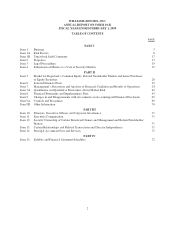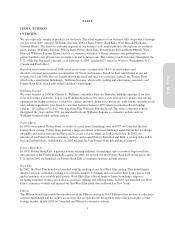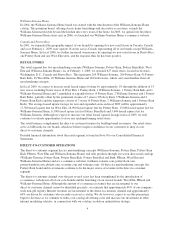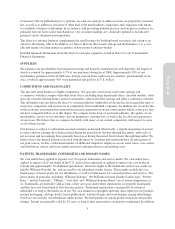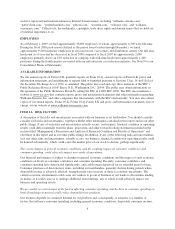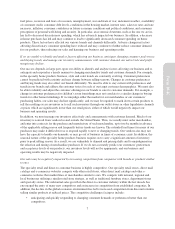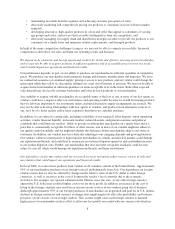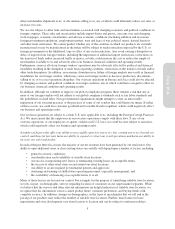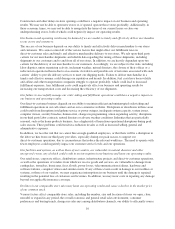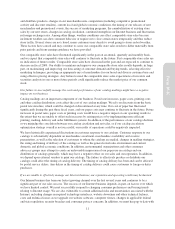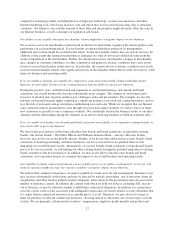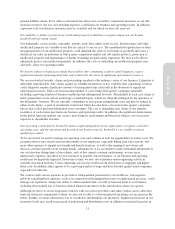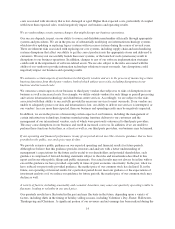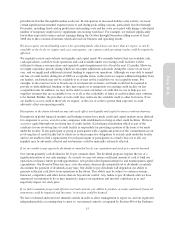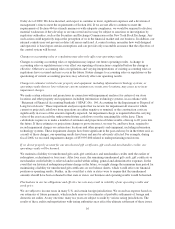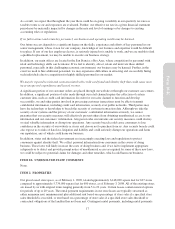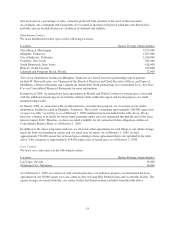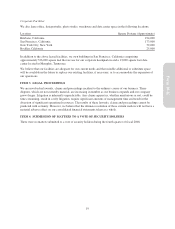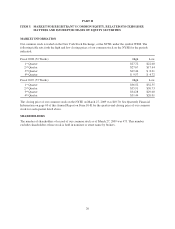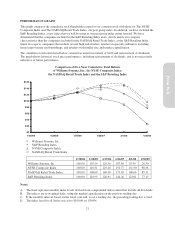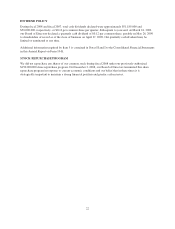Pottery Barn 2008 Annual Report Download - page 24
Download and view the complete annual report
Please find page 24 of the 2008 Pottery Barn annual report below. You can navigate through the pages in the report by either clicking on the pages listed below, or by using the keyword search tool below to find specific information within the annual report.competitive technology trends, including the use of improved technology, creative user interfaces and other
Internet marketing tools, which may increase costs and which may not succeed in increasing sales or attracting
customers. Our failure to successfully respond to these risks and uncertainties might adversely affect the sales in
our Internet business, as well as damage our reputation and brands.
Our failure to successfully anticipate merchandise returns might have a negative impact on our business.
We record a reserve for merchandise returns based on historical return trends together with current product sales
performance in each reporting period. If actual returns are greater than those projected by management,
additional sales returns might be recorded in the future. Actual merchandise returns may exceed our reserves. In
addition, to the extent that returned merchandise is damaged, we often do not receive full retail value from the
resale or liquidation of the merchandise. Further, the introduction of new merchandise, changes in merchandise
mix, changes in consumer confidence, or other competitive and general economic conditions may cause actual
returns to exceed merchandise return reserves. In particular, the current adverse economic conditions may result
in increased merchandise returns. Any significant increase in merchandise returns that exceeds our reserves could
harm our business and operating results.
If we are unable to manage successfully the complexities associated with a multi-channel and multi-brand
business, we may suffer declines in our existing business and our ability to attract new business.
During the past few years, with the launch and expansion of our Internet business, new brands and brand
extensions, our overall business has become substantially more complex. The changes in our business have
forced us to develop new expertise and face new challenges, risks and uncertainties. For example, we face the
risk that our Internet business might cannibalize a significant portion of our retail and catalog businesses, and we
face the risk of increased catalog circulation cannibalizing our retail sales. While we recognize that our Internet
sales cannot be entirely incremental to sales through our retail and catalog channels, we seek to attract as many
new customers as possible to our e-commerce websites. We continually analyze the business results of our three
channels and the relationships among the channels, in an effort to find opportunities to build incremental sales.
If we are unable to introduce new brands and brand extensions successfully, or to reposition existing brands, we
may not be able to grow our business.
We have in the past and may in the future introduce new brands and brand extensions, or reposition existing
brands. Our newest brands – West Elm, PBteen and Williams-Sonoma Home – and any other new brands,
however, may not be successful growth vehicles. Further, if we devote time and resources to new brands, brand
extensions or brand repositioning, and those businesses are not as successful as we planned, then we risk
damaging our overall business results. Alternatively, if our new brands, brand extensions or repositioned brands
prove to be very successful, we risk hurting our other existing brands through the potential migration of existing
brand customers to the new businesses. In addition, we may not be able to introduce new brands and brand
extensions, or to reposition brands, in a manner that improves our overall business and operating results.
Our inability to obtain commercial insurance at acceptable prices or our failure to adequately reserve for self-
insured exposures might increase our expenses and have a negative impact on our business.
We believe that commercial insurance coverage is prudent in certain areas for risk management. Insurance costs
may increase substantially in the future and may be affected by natural catastrophes, fear of terrorism, financial
irregularities and other fraud at publicly-traded companies, intervention by the government and a decrease in the
number of insurance carriers. In addition, the carriers with which we hold our policies, including AIG, may go
out of business, or may be otherwise unable to fulfill their contractual obligations. In addition, for certain types
or levels of risk, such as risks associated with earthquakes, hurricanes or terrorist attacks, we may determine that
we cannot obtain commercial insurance at acceptable prices, if at all. Therefore, we may choose to forego or
limit our purchase of relevant commercial insurance, choosing instead to self-insure one or more types or levels
of risks. We are primarily self-insured for workers’ compensation, employee health benefits and product and
12


